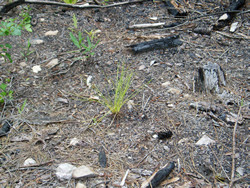
National Fire Plan Success Story
Prescribed Fire Program and Partnership Begins Restoration of Native Longleaf Pine
Horseshoe Bend National Military Park, Alabama
National Fire Plan - Rehabilitation
2009

A grass stage longleaf pine planted at Horseshoe Bend National Military Park. Note the absence of a significant duff layer. NPS photo by Jim Cahill.
In 2006, the National Park Service (NPS) began a prescribed fire program at Horseshoe Bend National Military Park, primarily for reducing hazardous fuels that had built up in the past four decades of the park’s existence. Prescribed burns are carried out at Horseshoe Bend by the NPS Great Smoky Mountains Wildland Fire Module, one of two such modules located in the NPS Southeast Region.
Auburn University became an active partner in the park’s prescribed fire activities and faculty members noted a scattering of native longleaf pine trees throughout the park. The pines were native to the area and would have been more prevalent during the park’s period of historical significance from 1800 to 1830. Years of duff accumulation had stunted the pine’s ability to regenerate naturally. Treatment with prescribed fire has reduced duff layers in several areas to the point that some grass stage longleaf seedlings have been reintroduced.
In 2009, Auburn University researchers Drs. Sharon Hermann and John Kush, working with a grant funded by the National Fish and Wildlife Foundation, purchased and planted 1,565 containerized seedlings scattered over 10 small gaps throughout the park. This is a pilot effort to learn about the success of planting containerized longleaf in small regeneration gaps in a disturbed anthropogenic, fire-excluded landscape.
The NPS fire management program at Horseshoe Bend, in partnership with Auburn University, shows how prescribed fire can help protect natural areas from wildfire while restoring native species.
Contact: Jim Cahill, Horseshoe Bend Fire Management Officer, (256) 234-7111 x223.